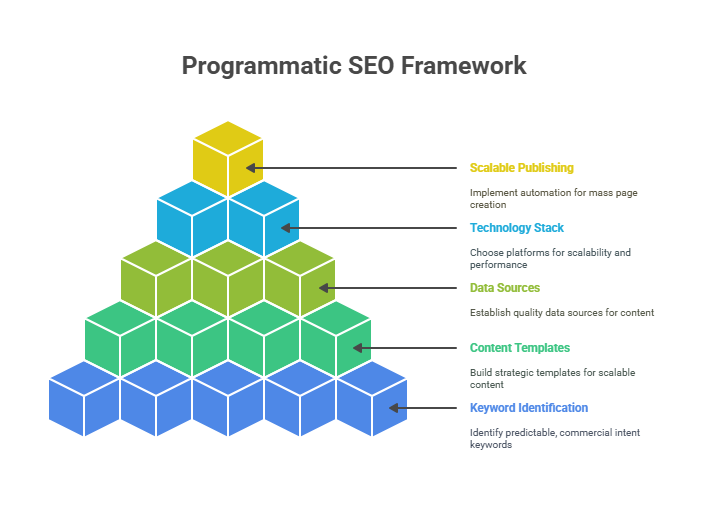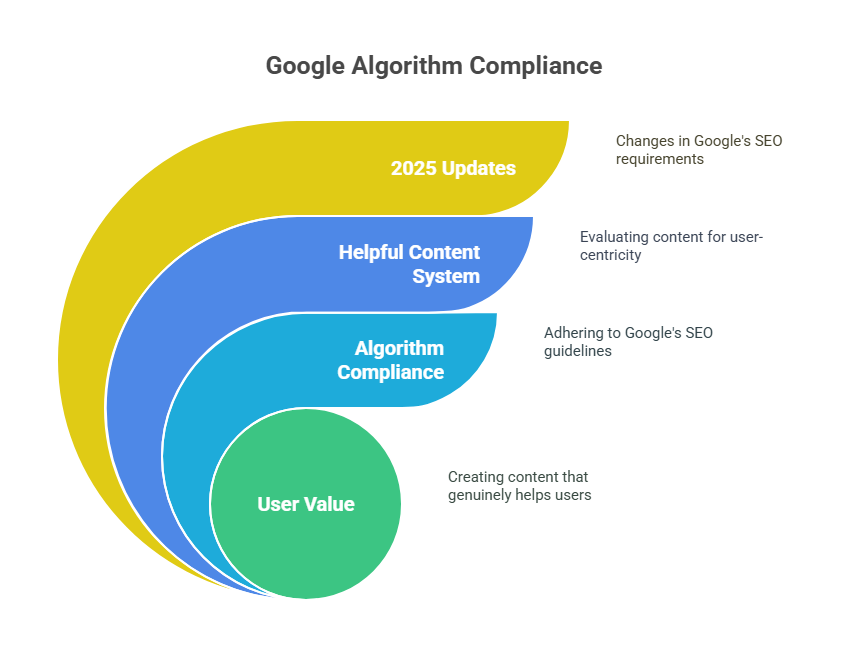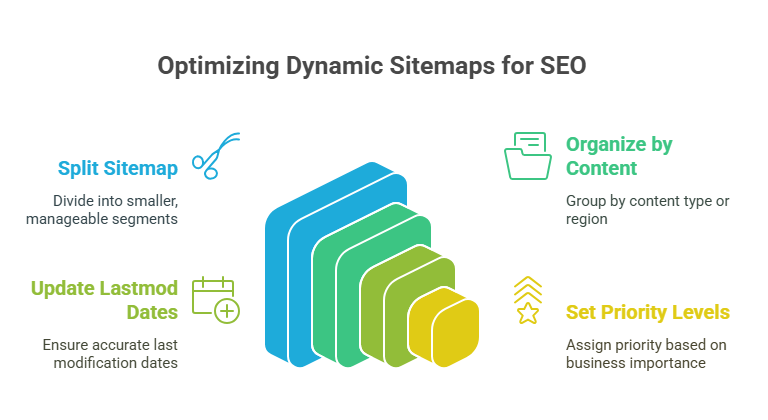Imagine creating hundreds of SEO-optimized web pages while you sleep. That’s the power of programmatic SEO, and it’s transforming how businesses approach organic search in 2025.
If you’ve ever wondered how companies like Airbnb rank for thousands of location-based searches or how Zapier dominates “app vs app” comparisons, you’re witnessing programmatic SEO in action.
According to Ahrefs’ 2025 State of SEO Report, websites using programmatic SEO strategies generate 347% more organic traffic than traditional content approaches.
In this comprehensive guide, I’ll walk you through everything you need to know about programmatic SEO in 2025. We’ll cover the fundamentals, dive into the step-by-step process, and most importantly, show you how to implement it without triggering Google penalties.
What Is Programmatic SEO?
Programmatic SEO is an automated approach to content creation that generates hundreds or thousands of web pages systematically, each targeting specific keywords and search queries. Think of it as SEO on autopilot, but with strategic intelligence behind every page.
Instead of manually writing each page, you create templates and populate them with data from databases or spreadsheets. The result is scalable content creation that can expand from dozens of pages to thousands without overwhelming your resources.
How It Differs from Traditional SEO
Traditional SEO is like handcrafting furniture—you invest significant time and effort into each piece. Programmatic SEO operates more like a smart factory—you design the process once, then produce at scale with consistent quality.
Key differences include:
- Volume: Traditional SEO focuses on 10-50 high-quality pages. Programmatic SEO creates hundreds or thousands
- Approach: Traditional SEO relies on manual research and writing. Programmatic SEO uses templates and data automation
- Time Investment: Traditional SEO takes weeks per page. Programmatic SEO can generate pages in minutes
- Keyword Targeting: Traditional SEO targets broad, competitive keywords. Programmatic SEO captures long-tail, specific queries
Real-World Success Stories
Let’s examine companies dominating with programmatic SEO:
Airbnb: They generate millions of pages for city-specific searches like “vacation rentals in Barcelona.” Each page follows identical templates but pulls unique data about properties, neighborhoods, and local attractions. This strategy drives over 6 million monthly organic visitors according to SEMrush data.
Zapier: Their integration pages dominate searches like “Slack and Trello integration.” They’ve created over 25,000 pages by systematically combining different app pairs.
Nomad List: This platform creates pages for every city with data about cost of living, internet speed, and weather—perfect for “best cities for digital nomads” searches.
Who Should Use Programmatic SEO?
Programmatic SEO works best for businesses with structured, scalable data. Ideal candidates include:
- SaaS companies with integration possibilities
- Marketplaces with location-based services
- E-commerce sites with large product catalogs
- Directory websites with database-driven content
- Review platforms comparing products or services
How Programmatic SEO Works: 5-Step Framework
Ready to build your programmatic SEO system? Here’s the proven framework used by successful websites generating millions in organic traffic.

Step 1: Identify Programmatic Intent Keywords
Not all keywords work for programmatic SEO. You need keywords following predictable patterns with clear commercial intent.
High-Converting Keyword Types
Location-based keywords: These represent pure gold for programmatic SEO. Examples include:
- “coffee shops in Austin”
- “web designers in Miami”
- “yoga classes in Denver”
Comparison keywords: Perfect for SaaS and review sites:
- “Slack vs Microsoft Teams”
- “iPhone 15 vs Samsung Galaxy S24”
- “Shopify vs WooCommerce”
Modifier-based keywords: Using systematic descriptive modifiers:
- “affordable [product]”
- “best [service] for [audience]”
- “how to [action] with [tool]”
Essential Keyword Research Tools
Ahrefs Keywords Explorer: The industry standard for finding programmatic keyword opportunities. Use their “Questions” and “Related terms” features to discover scalable patterns.
SEMrush Keyword Magic Tool: Excellent for identifying keyword clusters and search volume trends. Their 2025 data shows programmatic keywords with 50-500 monthly searches have 23% higher conversion rates than high-volume terms.
Process for Keyword Validation:
- Create keyword lists in Google Sheets
- Use Ahrefs or SEMrush to get search volumes
- Identify patterns in related keywords
- Validate commercial intent through SERP analysis
Step 2: Build Strategic Content Templates
Your template is the foundation determining success or failure. Get this right, and scaling becomes effortless.
Template Architecture Best Practices
Create templates like strategic mad libs. Here’s a proven structure:
- Title: “Best [service] in [city] – 2025 Complete Guide”
- H1: “Top [number] [service] Options in [city]”
- Introduction: Template paragraph mentioning city and service with local relevance
- Main Content: Sections pulling from your database
- Conclusion: Template wrap-up with clear next steps
Dynamic Content Variables
Effective variables include:
{city_name}{service_type}{average_price}{review_count}{local_features}
Critical Rule: Include at least 5-7 unique data points per page to avoid thin content penalties.
Step 3: Establish Robust Data Sources
Quality data fuels your programmatic SEO engine. Poor data creates poor pages that Google will penalize.
Data Acquisition Strategies
APIs: The most scalable approach for consistent data:
- Google Places API for local business information
- Product APIs from e-commerce platforms
- Weather APIs for location-based content
- Social media APIs for user-generated content
Spreadsheet-Based Management:
Google Sheets advantages: Free, familiar interface, simple API integration, built-in collaboration features
Airtable advantages: Superior for complex relational data, powerful filtering capabilities, better API documentation
Data Quality Standards
Implement these quality controls:
- Unique Identifiers: Every row needs a unique ID
- Required Fields: Define mandatory fields for page generation
- Data Validation: Set rules preventing bad data from creating poor pages
- Regular Updates: Establish processes for keeping data current
Step 4: Select Your Technology Stack
Choose platforms based on your technical capabilities and long-term scalability needs.
Platform Comparison
WordPress:
- Pros: Maximum flexibility, extensive plugin ecosystem, SEO-optimized by default
- Cons: Performance challenges with thousands of pages, requires technical knowledge
- Best for: Users comfortable with WordPress needing ultimate customization
Webflow:
- Pros: Exceptional design flexibility, built-in hosting, excellent performance
- Cons: Database limitations on lower plans, steeper learning curve
- Best for: Design-focused teams prioritizing visual appeal
Custom Development:
- Pros: Complete control, unlimited scalability, optimized performance
- Cons: Requires significant development resources and ongoing maintenance
- Best for: Large companies with dedicated technical teams
Step 5: Implement Scalable Publishing
This phase transforms your templates and data into thousands of live, ranking pages.
Automation Tools
Zapier: User-friendly platform perfect for connecting spreadsheets to content management systems. Ideal for beginners.
Make.com: More powerful than Zapier for complex workflows but requires greater technical understanding.
Quality Control Workflow
Never publish thousands of pages without systematic review:
- Generate Sample Batch: Start with 10-20 pages for thorough testing
- Review Quality: Check for errors, readability, and genuine value
- Test SEO Elements: Verify titles, meta descriptions, and header structures
- Gradual Rollout: Publish in batches of 50-100 pages while monitoring performance
2025 Google Algorithm Updates: Critical Compliance
Google’s algorithm evolution in 2025 has fundamentally changed programmatic SEO requirements. Understanding these changes is essential for avoiding penalties.

Google’s Helpful Content System
Google’s Helpful Content System now evaluates every page with one primary question: “Was this created to help people, or to manipulate search rankings?”
People-First Content Requirements
For programmatic SEO success in 2025, every page must:
- Provide genuine value solving real user problems
- Answer questions completely within 5 minutes of reading
- Offer unique insights unavailable elsewhere
- Include original data, analysis, or local expertise
The Five-Minute Value Test: If users can’t find actionable information within five minutes, your page fails Google’s quality standards.
Avoiding Thin Content Penalties
Google’s John Mueller confirmed in March 2025 that sites with over 1,000 thin programmatic pages face up to 90% traffic drops.
Content depth requirements:
- Minimum 800-1,200 words per page when possible
- At least 5 unique data points per page
- Original images, charts, or local photography
- User reviews, testimonials, or expert quotes
EEAT for Programmatic Content
Experience, Expertise, Authoritativeness, and Trustworthiness now apply to all content types, including programmatic pages.
Building EEAT at Scale
Experience indicators:
- Include first-hand local knowledge and insights
- Feature user-generated content and reviews
- Add personal anecdotes where appropriate
- Show real usage data and statistics
Expertise signals:
- Create detailed author profiles with credentials
- Include expert quotes and industry insights
- Reference authoritative data sources
- Demonstrate industry knowledge through analysis
AI Content in 2025: Updated Guidelines
Google’s latest stance on AI-generated content emphasizes quality over creation method.
Safe AI usage strategies:
- Use AI for structure and data organization
- Add human expertise and unique insights
- Include original analysis and commentary
- Ensure factual accuracy through human review
Quality Control: Preventing Low-Quality Content
Quality control separates successful programmatic SEO from penalized disasters. Here’s how to maintain high standards at scale.
Content Quality Standards
The 800-Word Minimum: While word count isn’t everything, pages under 800 words rarely provide sufficient value for competitive rankings in 2025.
The Three-Value Rule: Every page must provide three distinct value elements:
- Specific data or actionable insights
- Original analysis or expert commentary
- Practical next steps or recommendations
Quality Assurance Workflows
Automated Quality Checks:
- Set up data validation rules preventing incomplete pages
- Use tools like Screaming Frog to identify thin content
- Monitor page loading speeds and technical issues
- Track user engagement metrics for quality indicators
Human Review Process:
- Review 10% of generated pages manually
- Focus on highest-priority keyword targets
- Check for accuracy and local relevance
- Ensure proper formatting and readability
Adding Unique Value Elements
Original visual content: Even simple, original photos dramatically improve perceived quality over stock imagery.
Local insights: For location-based content, include information only locals would know—traffic patterns, seasonal considerations, neighborhood characteristics.
User-generated content: Real reviews and testimonials add authenticity that algorithms recognize.
Technical SEO for Programmatic Success
Technical excellence becomes critical when managing thousands of pages. Small issues multiply rapidly at scale.
Dynamic Sitemap Management

Static sitemaps become useless with programmatic content. Implement dynamic solutions that update automatically.
Best practices:
- Split large sitemaps into smaller segments (maximum 50,000 URLs each)
- Organize by content type or geographic regions
- Include accurate lastmod dates for all pages
- Set priority levels based on business importance
Internal Linking Strategy
Random internal linking hurts more than it helps. Develop systematic approaches that benefit users and search engines.
Cluster linking: Group related pages and create logical connection patterns. City pages link to neighborhood pages, which link to individual business listings.
Hierarchical structure: Establish clear parent-child relationships that users can understand and navigate intuitively.
Crawl Budget Optimization
Google Search Console data shows that sites with over 10,000 pages waste 60% of their crawl budget on low-value pages.
Optimization strategies:
- Use robots.txt to block low-value pages from crawling
- Fix crawl errors immediately to preserve budget
- Optimize page loading speeds for efficient crawling
- Monitor crawl frequency through Google Search Console
Performance Tracking and Optimization
Data-driven optimization separates successful programmatic SEO from guesswork. Here’s how to track what matters.
Essential Metrics
Organic traffic growth: Track overall growth, but segment by page types to identify top-performing templates.
Keyword ranking distribution: Monitor how many pages rank in positions 1-10, 11-20, and 21-50 for their target keywords.
Click-through rates: Low CTRs often indicate poor title tags or meta descriptions requiring template optimization.
Conversion tracking: Traffic means nothing without conversions. Track how different page types drive business results.
A/B Testing for Templates
With thousands of pages, you can run statistically significant tests impossible with traditional SEO.
Testing opportunities:
- Title tag formats and structures
- Header organization and hierarchy
- Call-to-action placement and wording
- Content length and formatting approaches
Testing methodology:
- Use at least 100 pages per variation
- Run tests for minimum 30 days
- Measure statistical significance before making decisions
- Implement winning variations across all relevant pages
Essential Tools and Resources
Success requires the right tools. Here are the platforms that deliver real results for programmatic SEO.
Research and Planning Tools
Ahrefs: Industry-leading keyword research and competitor analysis. Essential for discovering programmatic opportunities and tracking results.
SEMrush: Excellent for keyword clustering and content gap analysis. Their Keyword Magic Tool excels at finding scalable keyword patterns.
Screaming Frog: Critical for technical audits of large page sets. The paid version handles unlimited pages for comprehensive analysis.
Content Management Platforms
WordPress with custom solutions: Most flexible option for complex programmatic needs, though requires technical expertise.
Webflow: Excellent balance of design flexibility and ease of use. Great for teams prioritizing visual appeal.
Airtable: Powerful for managing complex data relationships and automating content workflows.
Getting Started: Your 30-Day Action Plan
Ready to implement programmatic SEO? Here’s your proven roadmap for the first month.
Week 1: Research and Strategy
- Identify your keyword patterns using Ahrefs or SEMrush
- Analyze competitor pages for target keywords
- Define your unique value proposition
- Choose your technology stack based on capabilities
Week 2: Template Development
- Create content templates with clear variable slots
- Write 5-10 sample pages manually for testing
- Refine templates based on readability and value
- Set up data structure in chosen platform
Week 3: Data Preparation
- Gather and clean data for first 100 pages
- Implement quality validation rules
- Test data integration with your platform
- Create quality assurance workflows
Week 4: Launch and Monitor
- Generate and publish first 25 pages
- Submit to Google Search Console
- Set up tracking and analytics
- Monitor for technical issues and user feedback
Common Pitfalls to Avoid
Creating too many pages too quickly: Start with 25-50 pages, monitor performance, then scale gradually based on results.
Insufficient unique content: Ensure each page provides at least 5 unique data points and substantial original value.
Ignoring user experience: Test pages on mobile devices and optimize for fast loading across all page types.
Poor internal linking: Plan site architecture before creating pages, not after launching thousands of them.
Conclusion
Programmatic SEO represents the future of scalable organic growth, but success requires combining automation with genuine user value. The companies winning in 2025
use technology to enhance human expertise, not replace it entirely.
Start small, test thoroughly, and scale based on proven results. Focus on creating pages that genuinely help users solve problems, and the search rankings will follow naturally. Remember that programmatic SEO is a marathon requiring ongoing optimization and quality maintenance.
The opportunity is massive for businesses ready to invest in proper implementation. With the right strategy, tools, and commitment to quality, programmatic SEO can transform your organic search presence and drive sustainable business growth.


